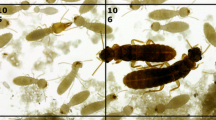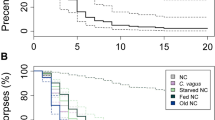Abstract
In order to maintain healthy colonies, termite workers dispose of the cadavers of dead nest mates by cannibalism, burial, or necrophoresis. However, when multiple reproductives found a new colony by pleometrosis, there are no worker castes at the early stages of the foundation to eliminate or isolate the corpses. In this study, we showed that in young pleometrotic colonies, reproductives of Pseudacanthotermes spiniger had the ability to perform this task. Because of the claustral conditions, and the potential inability of the dealates to feed on their own, their behaviour was restricted to the burial of the cadaver within the initial chamber. This burial behaviour, previously not reported in the reproductive caste of termites, appeared to be induced by chemical signals released by the corpses during decomposition, among which various fatty acids, indole and phenol were the most active. The burial finally resulted in the physical isolation of corpses, thus reducing the chances for opportunistic pathogens to spread among the rest of the individuals.





Similar content being viewed by others
References
Arathi H.S., Burn I. and Spivak M. 2000. Ethology of hygienic behaviour in the honey bee Apis mellifera L. (Hymenoptera: Apidae): Behavioural repertoire of hygienic bees. Ethology 106: 365-379
Ataya H. and Lenoir A. 1984. Le comportement nécrophorique chez la fourmi Lasius niger L. Insect. Soc. 31: 20-33
Brandl R., Hacker M., Bagine R.K.N. and Kaib M. 2001. Geographic variation of polygyny in the termite Macrotermes michaelseni (Sjöstedt). Insect. Soc. 48: 134-137
Choe D.-H., Millar J.G. and Rust M.K. 2009. Chemical signals associated with life inhibit necrophoresis in Argentine ants. Proc. Natl. Acad. Sci. USA 106: 8251-8255
Chouvenc T. and Su N.-Y. 2010. Apparent synergy among defense mechanisms in subterranean termites (Rhinotermitidae) against epizootic events - The limits and potential for biological control. J. Econ. Entomol. 103: 1327-1337
Cremer S., Armitage S.A.O. and Schmid-Hempel P. 2007. Social immunity. Curr. Biol. 17: 693-702
Crosland M.W.J., Lok C.M., Wong T.C., Shakarad M. and Traniello J.F.A. 1997. Division of labour in a lower termite: the majority of tasks are performed by older workers. Anim. Behav. 54: 999-1012
Darlington J.P.E.C. 1985. Multiple primary reproductives in the termite Macrotermes michaelseni (Sjöstedt). In: Caste Differentiation in Social Insects (Watson J.A.L., Okot-Kotber B.M. and Noirot Ch., Eds), Pergamon, New York. pp 187-200
Darlington J.P.E.C. 1994. Mound structure and nest population of the termite Pseudacanthotermes spiniger (Sjöstedt) in Kenya. Insect Sci. Applic. 15: 445-452
Diez L., Deneubourg J.L., Hoebeke L. and Detrain C. 2011. Orientation in corpse-carrying ants: memory or chemical cues? Anim. Behav. 81: 1171-1176
Gordon D.M. 1983. Dependence of necrophoric response to oleic acid on social context in the ant Pogonomyrmex badius. J. Chem. Ecol. 9: 104-111
Grassé P.-P. 1982. Termitologia. Tome I: Anatomie - Physiologie - Reproduction. Masson, Paris
Hart A.G. and Ratnieks F.L.W. 2002. Waste management in the leaf-cutting ant Atta colombica. Behav. Ecol. 13: 224-231
Haskins C.P. and Haskins E.F. 1974. Note on necrophoric behaviour in the archaic ant Myrmecia vindex (Formicidae: Myrmeciinae). Psyche 81: 258-267
Howard D.F. and Tschinkel W.R. 1976. Aspect of necrophoric behaviour in the red imported ant, Solenopsis invicta. Behaviour 56: 157-180
Kaib M., Hacker M., and Brandl R. 2001. Egg-laying in monogynous colonies of the termite Macrotermes michaelseni (Isoptera: Macrotermitinae). Insect. Soc. 48: 231-237
Lamberty M., Zachary D., Lanot R., Bordereau C., Robert A., Hoffmann J.A. and Bulet P. 2001. Constitutive expression of a cysteine-rich antifungal and linear antibacterial peptide in a termite insect. J. Biol. Chem. 276: 4085-4096
Logan J.W.M., Cowie R.H. and Wood T.G. 1990. Termite (Isoptera) control in agriculture and forestry by non-chemical methods: a review. Bull. Entomol. Res. 80:309-330
Lopez-Riquelme G.O., Malo E.A, Cruz-Lopez L. and Fanjul-Moles M.L. 2006. Antennal olfactory sensitivity in response to task-related odours of three castes of the ant Atta mexicana (Hymenoptera: Formicidae). Physiol. Entomol. 31: 353-360
Mjöberg E. 1920. Results of Dr E. Mjöberg’s Swedish scientific expeditions to Australia, 1910-1913. Isoptera. Ark. Zool. 12: 1-128
Nutting W.L. 1969. Flight and colony foundation. In: Biology of Termites, Vol. 1 (Krishna K. and Weesner F.M., Eds), Academic Press, New York. pp 233-282
Pearce M.J. 1987. Seals, tombs, mummies, and tunneling in the drywood termite Cryptotermes (Isoptera: Kalotermitidae). Sociobiology 13 : 217-226
Peppuy A. 1999. Termites du Nord Vietnam, communication chimique et isolement spécifique. Thèse de Doctorat, Université Pierre et Marie Curie, Paris VI, 155 pp
Purnamadjaja A.H. and Russell R.A. 2005. Pheromone communication in robot swarm: Necrophoric behaviour bee behaviour and its replication. Robotica 23: 731-742
Renucci M., Tirard A. and Provost E. 2011. Complex undertaking behaviour in Temnothorax lichtensteini ant colonies: from corpse-burying behaviour to necrophoric behaviour. Insect. Soc. 58: 9-16
Roisin Y. 1993. Selective pressures on pleometrosis and secondary polygyny: a comparison of termites and ants. In: Queen Number and Sociality in Insects (Keller L., Ed), Oxford University Press, NewYork. pp 402-421
Rosengaus R.B., Traniello J.F.A and Bulmer M.S. 2011. Ecology, behaviour and evolution of disease resistance in termites. In: Biology of Termites: a Modern Synthesis (Bignell D.E., Roisin Y. and Lo N., Eds) Springer, Dordrecht. pp 165-191
Skidmore B.A. and Heithaus E.R. 1988. Lipid cues for seed-carrying by ants in Hepatica americana. J. Chem. Ecol. 14: 2185-2196
Su N.-Y. 1982. An ethological approach to the remedial control of the Formosan subterranean termite, Coptotermes formosanus Shiraki. Ph.D. dissertation, University of Hawaii, Honolulu
Thorne B.L. 1984. Polygyny in the Neotropical termite Nasutitermes corniger: life history consequences of queen mutualism. Behav. Ecol. Sociobiol. 14: 117-136
Trumbo S.T. and Robinson G.E. 1997. Learning and task interference by corpse-removal specialists in honey bee colonies. Ethology 103: 966-975
Visscher P.K. 1983. The honey bee way of death: necrophoric behaviour in Apis mellifera. Anim. Behav. 31: 1070-1076
Wilson E.O., Durlach N.I. and Roth L.M. 1958. Chemical releasers of necrophoric behaviour in ants. Psyche 65: 108-114
Wilson-Rich N., Stuart R.J. and Rosengaus R.B. 2007. Susceptibility and behavioural response of the dampwood termite Zootermopsis angusticollis to the entomopathogenic nematode Steinernea carpocapsae. J. invertebr. Pathol. 95: 17-25
Acknowledgments
We thank Paul Bardunias (University of Florida) for reviewing the manuscript, two anonymous reviewers for their valuable suggestions and Odile Bonnard for technical assistance. This study was part of T. Chouvenc M.Sc. Thesis.
Author information
Authors and Affiliations
Corresponding author
Rights and permissions
About this article
Cite this article
Chouvenc, T., Robert, A., Sémon, E. et al. Burial behaviour by dealates of the termite Pseudacanthotermes spiniger (Termitidae, Macrotermitinae) induced by chemical signals from termite corpses. Insect. Soc. 59, 119–125 (2012). https://doi.org/10.1007/s00040-011-0197-3
Received:
Revised:
Accepted:
Published:
Issue Date:
DOI: https://doi.org/10.1007/s00040-011-0197-3




